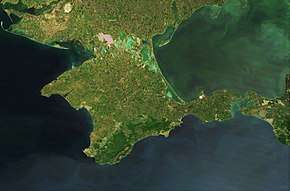Crimean Tatars
Crimean Tatars (Crimean Tatar: qırımtatarlar, къырымтатарлар), or Crimeans (Crimean Tatar: qırımlar, къырымлар), are a Turkic ethnic group and nation, who are an indigenous people of Crimea. The formation and ethnogenesis of Crimean Tatars occurred during the 13th–17th centuries, from Cumans that appeared in Crimea in the 10th century, with strong contributions from all the peoples who ever inhabited Crimea, including Greeks, Italians, and Goths.[11] International indigenous groups do not dispute their status as an indigenous people and they have been officially recognized as an indigenous people of Ukraine since 2014.[12][13] Currently the Russian government considers Crimean Tatars to be a "national minority", not an indigenous people of Crimea,[14] and continues to deny that they are a titular people of Crimea; however, before the deportation and exile of Crimean Tatars from Crimea in 1944 and the subsequent dissolution of the Crimean ASSR the Soviet government considered Crimean Tatars to be the indigenous people of the Crimea.[15][16][17][18]
qırımtatarlar, къырымтатарлар qırımlılar, къырымлылар | |
|---|---|
 Flag of the Crimean Tatars | |
| Regions with significant populations | |
| 246,073[1][2][3] | |
| 239,000[4] | |
| no exact data. According to various estimates from at least 150,000 to 6,000,000[5][6] | |
| 30,000–60,000 (excl. Crimea) | |
| 24,137[7] | |
| 2,449 (excl. Crimea)[8] | |
| 1,803[9] | |
| 1,532[10] | |
| 7,000 | |
| Languages | |
| Religion | |
| Sunni Islam | |
| Related ethnic groups | |
| Dobrujan Tatars, Nogais, Crimean Karaites | |
| Part of a series on |
| Crimean Tatars |
|---|
 |
| By region or country |
| Religion |
| Languages and dialects |
| History |
| People and groups |
|
Crimean Tatars constituted the majority of Crimea's population from the time of ethnogenesis until the mid-19th century, and the largest ethnic population until the end of the 19th century.[19][20] Almost immediately after the retaking of Crimea from Axis forces, in May 1944, the USSR State Defense Committee ordered the deportation of all of the Crimean Tatars from Crimea, including the families of Crimean Tatars serving in the Soviet Army. The deportees were transported in trains and boxcars to Central Asia, primarily to Uzbekistan. Starting in 1967, some were allowed to return, and in 1989 the Supreme Soviet of the Soviet Union condemned the removal of Crimean Tatars from their motherland as inhumane and lawless. Today, Crimean Tatars constitute approximately 15%[21] of the population of Crimea. There remains a large diaspora in Turkey and Uzbekistan.
The Crimean Tatars have been members of the Unrepresented Nations and Peoples Organization (UNPO) since 1991.[22]
Distribution
In the Ukrainian census of 2001, 248,200 Ukrainian citizens identified themselves as Crimean Tatars with 98% (or about 243,400) of them living in the Autonomous Republic of Crimea.[23][24] An additional 1,800 (or about 0.7%) live in the city of Sevastopol, also on the Crimean peninsula, but outside the border of the autonomous republic.[23]
About 150,000 remain in exile in Central Asia, mainly in Uzbekistan. The official number of Crimean Tatars in Turkey is 150,000 with some Crimean Tatar activists estimate a figure as high as 6 million. The activists reached this number by taking one million Tatar immigrants to Turkey as a starting point and multiplying this number by the birth rate in the span of the last hundred years.[6] Crimean Tatars in Turkey mostly live in Eskişehir Province, descendants of those who emigrated in the late 18th, 19th and early 20th centuries.[6] The Dobruja region of Romania and Bulgaria is home to more than 27,000 Crimean Tatars, with the majority in Romania and approximately 3,000 on the Bulgarian side of the border.[7]
Sub-ethnic groups
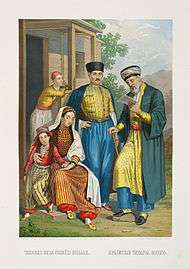
The Crimean Tatars are subdivided into three sub-ethnic groups:
- the Tats (not to be confused with the Iranic Tat people, living in the Caucasus region) who used to inhabit the mountainous Crimea before 1944 predominantly are Cumans, Greeks, Goths and other people, as Tats in Crimea also were called Hellenic Urum people (Greeks settled in Crimea) who were deported by the Imperial Russia to the area around Mariupol;[25]
- the Yaliboylu who lived on the southern coast of the peninsula;[25]
- the Noğays (not to be confused with related Nogai people, living now in Southern Russia) — former inhabitants of the Crimean steppe.[25]
Historians suggest that inhabitants of the mountainous parts of Crimea lying to the central and southern parts (the Tats), and those of the Southern coast of Crimea (the Yalıboyu) were the direct descendants of the Pontic Greeks, Armenians, Scythians, Ostrogoths (Crimean Goths) and Kipchaks along with the Cumans while the latest inhabitants of the northern steppe represent the descendants of the Nogai Horde of the Black Sea nominally subjects of the Crimean Khan.[26][27] It is largely assumed that the Tatarization process that mostly took place in the 16th century brought a sense of cultural unity through the blending of the Greeks, Armenians, Italians and Ottoman Turks of the southern coast, Goths of the central mountains, and Turkic-speaking Kipchaks and Cumans of the steppe and forming of the Crimean Tatar ethnic group.[28] However, the Cuman language is considered the direct ancestor of the current language of the Crimean Tatars with possible incorporations of the other languages like Crimean Gothic.[29][30][31][32]
Another theory suggests Crimean Tatars trace their origins to the waves of ancient people, Scythians, Greeks, Goths, Italians and Armenians.[33] When the Golden Horde invaded Crimea in the 1230s, they then mixed with populations which had settled in Eastern Europe, including Crimea since the seventh century: Tatars, but also Mongols and other Turkic groups (Khazars, Pechenegs, Cumans and Kipchaks), as well as the ancient.[34]
The Mongol conquest of the Kipchaks led to a merged society with the Mongol ruling class over a Kipchak speaking population which came to be known as Tatar and which eventually absorbed other ethnicities on the Crimean peninsula like Armenians, Italians, Greeks, and Goths to form the modern day Crimean Tatar people; up to the Soviet deportation, the Crimean Tatars could still differentiate among themselves between Tatar Kipchak Nogays and the "Tat" descendants of Tatarized Goths and other Turkified peoples.[35]
Goths, Gypsies, and Greeks were assumed to be some of the ancestors of the Tatars on the coast of Crimea, while there were "mixed hill Tatars" and "Asiatic" steppe Tatars.[36] Italians and Greeks mixed with the coastal Crimean Tatars.[37]
History
Origin

The Crimean Tatars were formed as a people in Crimea and are descendants of various peoples who lived in Crimea in different historical eras. The main ethnic groups that inhabited the Crimea at various times and took part in the formation of the Crimean Tatar people — the descendants of Tauri, Scythians and Sarmatians, Alans, Greeks, Goths, Bulgars, Khazars, Pechenegs, Italians, Circassians. The consolidation of this diverse ethnic conglomerate into a single Crimean Tatar people took place over the course of centuries. The connecting elements in this process were the commonality of the territory, the Turkic language and Islamic religion.[38][39][40][16][41][42]
An important role in the formation of the Crimean Tatar people belongs to the Western Kipchaks, known in historiography as Cumans. They became the consolidating ethnic group, which included all other peoples who inhabited the Crimea since ancient times. Kipchaks from the XI-XII century began to settle the Volga, Azov and black sea steppes (which from then until the XVIII century were called Desht-i Kipchak – "Cumanian steppe"). Since the second half of the XI century, they began actively moving to the Crimea. A significant part of the Cumans hid in the mountains of Crimea, fleeing after the defeat of the combined Cumanian-Russian troops from the Mongols and the subsequent defeat of the Cumanian proto-state formations in the Northern black sea region.
By the end of the XV century, the main prerequisites that led to the formation of an independent Crimean Tatar ethnic group were created: the political dominance of the Crimean Khanate was established in Crimea, the Turkic languages (Cuman-Kipchak on the territory of the khanate) became dominant, and Islam acquired the status of the state religion throughout the Peninsula. By a preponderance acquired the name "Tatars" of Cumanian population of the Crimea, the Islamic religion and Turkic language, the process of consolidating the multi-ethnic conglomerate of the Peninsula began, which has led to the emergence of the Crimean Tatar people.[16] For several centuries, on the basis of Cuman language with a noticeable Oghuz influence, the Crimean Tatar language has developed.[43][44][45][46]
Golden Horde and Crimean Khanate
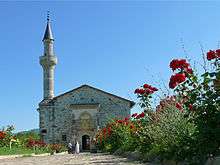
At the beginning of the 13th century, the Crimea, the majority of the population of which was already composed of a Turkic people — Cumans, became a part of the Golden Horde. The Crimean Tatars mostly adopted Islam in the 14th century and thereafter Crimea became one of the centers of Islamic civilization in Eastern Europe. In the same century, trends towards separatism appeared in the Crimean Ulus of the Golden Horde. De facto independence of the Crimea from the Golden Horde may be counted since the beginning of princess (khanum) Canike's, the daughter of the powerful Khan of the Golden Horde Tokhtamysh and the wife of the founder of the Nogai Horde Edigey, reign in the peninsula. During her reign she strongly supported Hacı Giray in the struggle for the Crimean throne until her death in 1437. Following the death of Сanike, the situation of Hacı Giray in Crimea weakened and he was forced to leave Crimea for Lithuania.[47]
The Crimean Tatars emerged as a nation at the time of the Crimean Khanate, an Ottoman vassal state during the 16th to 18th centuries.[48] Russian historian, doctor of history, Professor of the Russian Academy of Sciences Ilya Zaytsev writes that analysis of historical data shows that the influence of Turkey on the policy of the Crimea was not as high as it was reported in old Turkish sources and Imperial Russian ones.[49] The Turkic-speaking population of Crimea had mostly adopted Islam already in the 14th century, following the conversion of Ozbeg Khan of the Golden Horde.[50] By the time of the first Russian invasion of Crimea in 1736, the Khan's archives and libraries were famous throughout the Islamic world, and under Khan Krym-Girei the city of Aqmescit was endowed with piped water, sewerage and a theatre where Molière was performed in French, while the port of Kezlev stood comparison with Rotterdam and Bakhchysarai, the capital, was described as Europe's cleanest and greenest city.[51]

In 1441, an embassy from the representatives of several strongest clans of the Crimea, including the Golden Horde clans Shırın and Barın and the Cumanic clan — Kıpçak, went to the Grand Duchy of Lithuania to invite Hacı Giray to rule in the Crimea. He became the founder of the Giray dynasty, which ruled until the annexation of the Crimean Khanate by Russia in 1783.[52] Hacı I Giray was a Jochid descendant of Genghis Khan and of his grandson Batu Khan of the Golden Horde. During the reign of Meñli I Giray, Hacı's son, the army of the Great Horde that still existed then invaded the Crimea from the north, Crimean Khan won the general battle, overtaking the army of the Horde Khan in Takht-Lia, where he was killed, the Horde ceased to exist, and the Crimean Khan became the Great Khan and the successor of this state.[52][53] Since then, the Crimean Khanate was among the strongest powers in Eastern Europe until the beginning of the 18th century.[54] The Khanate officially operated as a vassal state of the Ottoman Empire, with great autonomy after 1580.[55] At the same time, the Nogai hordes, not having their own khan, were vassals of the Crimean one, Muskovy and Polish-Lithuanian commonwealth[56][57] paid annual tribute to the khan (until 1700[58] and 1699 respectively). In the 17th century, the Crimean Tatars helped Ukrainian Cossacks led by Bohdan Khmelnytsky in the struggle for independence, which allowed them to win several decisive victories over Polish troops.[59]
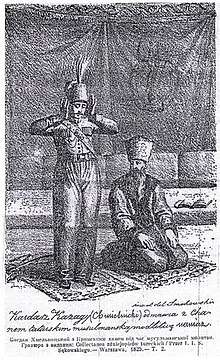
In 1711, when Peter I of Russia went on a campaign with all his troops (80,000) to gain access to the Black Sea, he was surrounded by the army of the Crimean Khan Devlet II Giray, finding himself in a hopeless situation. And only the betrayal of the Ottoman vizier Baltacı Mehmet Pasha allowed Peter to get out of the encirclement of the Crimean Tatars.[60] When Devlet II Giray protested against the vizier's decision,[61] his response was: "You should know your Tatar affairs. The affairs of the Sublime Porte are entrusted to me. You do not have the right to interfere in them".[62] Treaty of the Pruth was signed, and 10 years later, Russia declared itself an empire. In 1736, the Crimean Khan Qaplan I Giray was summoned by the Turkish Sultan Ahmed III to Persia. Understanding that Russia could take advantage of the lack of troops in Crimea, Qaplan Giray wrote to the Sultan to think twice, but the Sultan was persistent. As it was expected by Qaplan Giray, in 1736 the Russian army invaded the Crimea, led by Münnich, devastated the peninsula, killed civilians and destroyed all major cities, occupied the capital, Bakhchisaray, and burnt the Khan's palace with all the archives and documents, and then left the Crimea because of the epidemic that had begun in it. One year after the same was done by another Russian general — Peter Lacy.[52][63] Since then, the Crimean Khanate had not been able to recover, and its slow decline began. The Russo-Turkish War of 1768 to 1774 resulted in the defeat of the Ottomans by the Russians, and according to the Treaty of Küçük Kaynarca (1774) signed after the war, Crimea became independent and the Ottomans renounced their political right to protect the Crimean Khanate. After a period of political unrest in Crimea, Imperial Russia violated the treaty and annexed the Crimean Khanate in 1783.
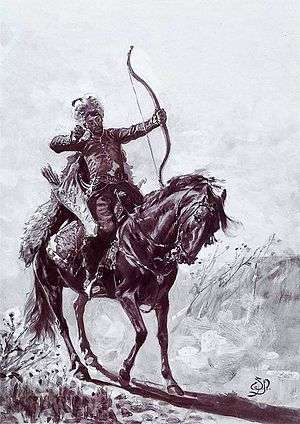
The main population of the Crimean khanate were Crimean Tatars, along with them in the Crimean khanate lived significant communities of Karaites, Italians, Armenians, Greeks, Circassians and Gypsies. In the early 16th century under the rule of the Crimean khans passed part of Nogays (Mangyts), who roamed outside the Crimean Peninsula, moving there during periods of drought and starvation. The majority of the population professed Islam of the Hanafi stream; part of the population – Orthodox, monotheletism, Judaism; in the 16th century. There were small Catholic communities. The Crimean Tatar population of the Crimean Peninsula was partially exempt from taxes. The Greeks paid dzhyziya, the Italians were in a privileged position due to the partial tax relief made during the reign of Meñli Geray I. By 18 century the population of the Crimean khanate was about 500 thousand people. The territory of the Crimean khanate was divided into kinakanta (governorship), which consisted of kadylyk, covering a number of settlements. Borders large beyliks, as a rule, do not coincide with the boundaries of kimcest and kadylyk.[64]
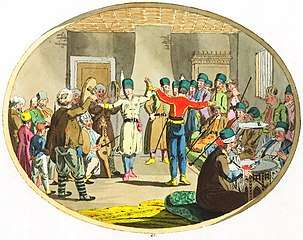
Until the beginning of the 18th century, Crimean Tatars were known for frequent, at some periods almost annual, devastating raids into Ukraine and Russia.[65][66][48][67] For a long time, until the late 18th century, the Crimean Khanate maintained a massive slave trade with the Ottoman Empire and the Middle East which was one of the important factors of its economy.[64][68] One of the most important trading ports and slave markets was Kefe.[69][70] According to the Ottoman census of 1526, taxes on the sale and purchase of slaves accounted for 24% of the funds, levied in Ottoman Crimea for all activities.[71] But in fact, there were always small raids committed by both Tatars and Cossacks, in both directions.[72] The 17th century Ottoman writer and traveller Evliya Çelebi wrote that there were 920,000 Ukrainian slaves in the Crimea but only 187,000 free Muslims.[48] However, the historian Sergei Gromenko considers this testimony of Çelebi a myth popular among ultranationalists, pointing out that today it is known from the writings on Economics that in the XVII century, the Crimea could feed no more than 500 thousand people.[73] For comparison, according to the notes of the Consul of France to Qırım Giray khan Baron Totta, a hundred years later, in 1767, there were 4 million people living in the Crimean khanate, [74] and in 1778, that is, just eleven years later, all the Christians were evicted from its territory by the Russian authorities, which turned out to be about 30 thousand, [75] Armenians and Greeks, and there were no Ukrainians among them. Also, according to more reliable modern sources than Evliya's data, slaves never constituted a significant part of the Crimean population.[76] Russian professor Glagolev writes that there were 1.800.000 free Crimean Tatars in the Crimean Khanate in 1666,[77] it also should be mentioned that a huge part of Ukraine was part of the Crimean Khanate, that is why Ukrainians could have been taken into account in the general population of the Khanate by Evliya (see Khan Ukraine).
Some researchers estimate that more than 2 million people were captured and enslaved during the time of the Crimean Khanate. Polish historian Bohdan Baranowski assumed that in the 17th century century Polish–Lithuanian Commonwealth (present-day Poland, Ukraine and Belarus) lost an average of 20,000 yearly and as many as one million in all years combined from 1500 to 1644.[48][78] In retaliation, the lands of Crimean Tatars were being raided by Zaporozhian Cossacks,[72] armed Ukrainian horsemen, who defended the steppe frontier – Wild Fields – against Tatar slave raids and often attacked and plundered the lands of Ottoman Turks and Crimean Tatars. The Don Cossacks and Kalmyk Mongols also managed to raid Crimean Tatars' land.[79] The last recorded major Crimean raid, before those in the Russo-Turkish War (1768–74) took place during the reign of Peter the Great (1682–1725).[72] However, Cossack raids continued after that time; Ottoman Grand Vizier complained to the Russian consul about raids to Crimea and Özi in 1761.[72] In 1769 one last major Tatar raid, which took place during the Russo-Turkish War, saw the capture of 20,000 slaves.[68]
Nevertheless, some historians (for instance, Russian historian Valeriy Vozgrin or Polish historian Oleksa Gayvoronsky) are sure that the role of the slave trade in the economy of the Crimean Khanate is greatly exaggerated by modern historians, and the raiding economy is nothing but a historical myth.[80][81] According to modern researches, livestock occupied a leading position in the economy of the Crimean Khanate, Crimean Khanate was one of the main wheat suppliers to the Ottoman Empire. Viticulture and winemaking, horticulture and gardening were also developed. Big income to the Khan's court brought salt mining.[64]
When reading the history of the Crimean Tatars, it is necessary to take into account that the historical science about the Crimean Tatars is strongly influenced by Russian historians who rewritten the history of the Crimean Khanate to justify the annexation of the Crimea in 1783, and, especially, then by Soviet historians who distorted the history of the Crimea to justify the 1944 genocide of the Crimean Tatars.[82][83][84][85][86]
In the Russian Empire
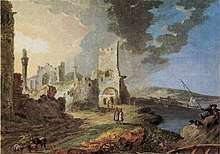
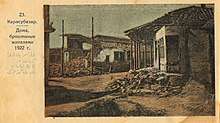
The Russo-Turkish War (1768–74) resulted in the defeat of the Ottomans by the Russians, and according to the Treaty of Küçük Kaynarca (1774) signed after the war, Crimea became independent and the Ottomans renounced their political right to protect the Crimean Khanate. After a period of political unrest in Crimea, Russia violated the treaty and annexed the Crimean Khanate in 1783. After the annexation, the wealthier Tatars, who had exported wheat, meat, fish and wine to other parts of the Black Sea, began to be expelled and to move to the Ottoman Empire. Due to the oppression by the Russian administration and colonial politics of Russian Empire, the Crimean Tatars were forced to immigrate to the Ottoman Empire. Further expulsions followed in 1812 for fear of the reliability of the Tatars in the face of Napoleon's advance. Particularly, the Crimean War of 1853–1856, the laws of 1860–63, the Tsarist policy and the Russo-Turkish War (1877–78) caused an exodus of the Tatars; 12,000 boarded Allied ships in Sevastopol to escape the destruction of shelling, and were branded traitors by the Russian government.[51] Of total Tatar population 300,000 of the Taurida Governorate about 200,000 Crimean Tatars emigrated.[87] Many Crimean Tatars perished in the process of emigration, including those who drowned while crossing the Black Sea. In total, from 1783 till the beginning of the 20th century, at least 800 thousand Tatars left Crimea. Today the descendants of these Crimeans form the Crimean Tatar diaspora in Bulgaria, Romania and Turkey.

Ismail Gasprali (1851–1914) was a renowned Crimean Tatar intellectual, influenced by the nationalist movements of the period, whose efforts laid the foundation for the modernization of Muslim culture and the emergence of the Crimean Tatar national identity. The bilingual Crimean Tatar-Russian newspaper Terciman-Perevodchik he published in 1883–1914, functioned as an educational tool through which a national consciousness and modern thinking emerged among the entire Turkic-speaking population of the Russian Empire.[51] After the Russian Revolution of 1917 this new elite, which included Noman Çelebicihan and Cafer Seydamet proclaimed the first democratic republic in the Islamic world, named the Crimean People's Republic on 26 December 1917. However, this republic was short-lived and abolished by the Bolshevik uprising in January 1918.[88]
In the Soviet Union (1917–1991)

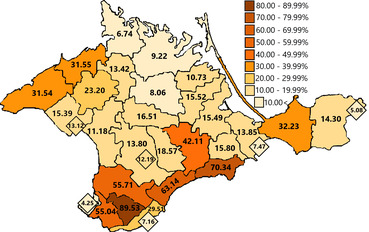
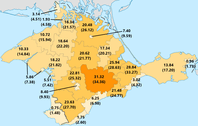
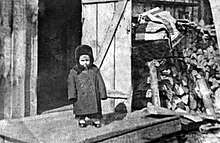
As a part of the Russian famine of 1921 the Peninsula suffered widespread starvation.[89] More than 100,000 Crimean Tatars starved to death,[89] and tens of thousands of Tatars fled to Turkey or Romania.[90] Thousands more were deported or killed during the collectivization in 1928–29.[90] The Soviet government's "collectivization" policies led to a major nationwide famine in 1931–33. During Stalin's Great Purge, statesmen and intellectuals such as Veli Ibraimov and Bekir Çoban-zade were imprisoned or executed on various charges.[90]
In May 1944, the entire Crimean Tatar population of Crimea was exiled to Central Asia, mainly to Uzbekistan, on the orders of Joseph Stalin, the General Secretary of the Communist Party of the Soviet Union and the Chairman of the USSR State Defense Committee. Although a great number of Crimean Tatar men served in the Red Army and took part in the partisan movement in Crimea during the war, the existence of the Tatar Legion in the Nazi army and the collaboration of Crimean Tatar religious and political leaders with Hitler during the German occupation of Crimea provided the Soviet leadership with justification for accusing the entire Crimean Tatar population of being Nazi collaborators. In actuality, much of this is Soviet denialism as the persecution of "suspect nations" and most of the genocide of the Crimean Tatars preceded the war, while statements justifying it appear after the war – as the threat of war heightened Stalin's perception of marginal and politically suspect populations as the potential source of an uprising in case of invasion. He began to plan for the preventive elimination of such potential recruits for a mythical "fifth column of wreckers, terrorists and spies". (Hagenloh, 2000; Shearer, 2003). Between 1917 and 1933, 150,000 Tatars—about 50% of the population at the time—either were killed or forced out of Crimea.[91]
Some modern researchers argue that Crimea's geopolitical position fueled Soviet perceptions of Crimean Tatars as a potential threat.[92] This belief is based in part on an analogy with numerous other cases of deportations of non-Russians from boundary territories, as well as the fact that other non-Russian populations, such as Greeks, Armenians and Bulgarians were also removed from Crimea (see Deportation of the peoples inhabiting Crimea).
All 240,000 Crimean Tatars were deported en masse, in a form of collective punishment, on 17–18 May 1944 as "special settlers" to the Uzbek Soviet Socialist Republic and other distant parts of the Soviet Union.[93] This event is called Sürgün in the Crimean Tatar language; the few who escaped were shot on sight or drowned in scuttled barges, and within months half their number had died of cold, hunger, exhaustion and disease.[51] Many of them were re-located to toil as forced labourers in the Soviet GULAG system.[94]
Civil rights movement
Causes
Starting in 1944, Crimean Tatars lived mostly in Central Asia with the designation as "special settlers", meaning that they had few rights. "Special settlers" were forbidden from leaving small designated areas and had to frequently sign in at a commandant's office.[95][96][97][98] Soviet propaganda directed towards Uzbeks depicted Crimean Tatars as threats to their homeland, and as a result there were many documented hate crimes against Crimean-Tatar civilians by Uzbek Communist loyalists.[99][100] In the 1950s the "special settler" regime ended, but Crimean Tatars were still kept closely tethered to Central Asia; while other deported ethnic groups like the Chechens, Karachays, and Kalmyks were fully allowed to return to their native lands during the Khrushchev thaw, economic and political reasons led to Moscow being reluctant to allow Crimean Tatars the same rights.[100] Moscow's refusal to allow a return was not only based out of a desire to satisfy the new Russian settlers in Crimea, who were very hostile to the idea of a return and had been subject to lots of Tatarophobic propaganda, but for economic reasons: high productivity from Crimean Tatar workers in Central Asia meant that letting the diaspora return would take a toll on Soviet industrialization goals in Central Asia.[96] Historians have long suspected that violent resistance to confinement in exile from Chechens led to further willingness to let them return, while the non-violent Crimean Tatar movement did not lead to any desire for Crimean Tatars to leave Central Asia. In effect, the government was punishing Crimean Tatars for being Stakhanovites while rewarding the deported nations that contributed less to the building of socialism, creating further resentment.[101][102]
Although a 1967 Soviet decree removed the charges against Crimean Tatars, the Soviet government did nothing to facilitate their resettlement in Crimea and to make reparations for lost lives and confiscated property.[103] Before the mass return in the perestroika era, Crimean Tatars made up only 1.5% of Crimea's population, since government entities at all levels took a variety of measures beyond the already-debilitating residence permit system to keep them in Central Asia.[104][105]
Methods
The abolition of the special settlement regime made it possible for Crimean Tatar rights activists to mobilize. The primary method of raising grievances with the government was petitioning. Many for the right of return gained over 100,000 signatures; although other methods of protest were occasionally used, the movement remained completely non-violent.[106][107] When only a small percentage of Crimean Tatars were allowed to return to Crimea, those who were not granted residence permits would return to Crimea and try to live under the radar. However, the lack of a residence permit resulted in a second deportation for them. A last-resort method to avoid a second deportation was self-immolation, famously used by Crimean Tatar national hero Musa Mamut, one of those who moved to Crimea without a residence permit. He doused himself with gasoline and committed self-immolation in front of police trying to deport him on 23 June 1978. Mamut died of severe burns several days later, but expressed no regret for having committed self-immolation.[107] Mamut posthumously became a symbol of Crimean Tatar resistance and nationhood, and remains celebrated by Crimean Tatars.[108] Other notable self-immolations in the name of the Crimean Tatar right of return movement include that of, who Shavkat Yarullin fatally committed self-immolation in front of a government building in protest in October 1989, and Seidamet Balji who attempted self-immolation while being deported from Crimea in December that year but survived.[109] Many other famous Crimean Tatars threatened government authorities with self-immolation if they continued to be ignored, including Hero of the Soviet Union Abdraim Reshidov. In the later years of the Soviet Union, Crimean Tatar activists held picket protests in Red Square.[110][98]
Results
After a prolonged effort of lobbying by the Crimean Tatar civil rights movement, the Soviet government established a commission in 1987 to evaluate the request for the right of return, chaired by Andrey Gromyko, aka "Mr. No".[111] Gromyko's condescending attitude[112] and failure to assure them that they would have the right of return[113] ended up concerning members of the Crimean Tatar civil rights movement. In June he rejected the request for re-establishment of a Crimean Tatar autonomy in Crimea and supported only small efforts for return, while agreeing to allow the lower-priority requests of having more publications and school instruction in the Crimean Tatar language at the local level among areas with the deported populations.[114] Gromyko's eventual conclusion that "no basis to renew autonomy and grant Crimean Tatars the right to return"[115] triggered widespread protests.[116][117] Anatoly Lukyanov from the commission had pointed out that other nations deported in the war were allowed to return, and noted that the case of the Kalmyks, who were deported less than a year before the Crimean Tatars for the same official reason but allowed to return to Kalmykia in the 1950s. Kalmyk collaboration with the Germans in the war was not used as a reason to treat Kalmyk civilians as second-class citizens in the 1980s, since by then they had become effectively rehabilitated, while the treatment of Crimean Tatars as second-class citizens at the time was often justified by reiterating the same official talking points about their alleged actions in World War II.[118] Less than two years after Gromyko's commission had rejected their request for autonomy and return, pogroms against the deported Meskhetian Turks were taking place in Central Asia. During the pogroms, some Crimean Tatars were targeted as well, resulting in changing attitudes towards allowing Crimean Tatars to move back to Crimea.[119] Eventually a second commission was established in 1989 to reevaluate the issue, and it was decided that the deportation was illegal and the Crimean Tatars were granted the full right to return, revoking previous laws intended to make it as difficult as possible for Crimean Tatars to move to Crimea.[120][121]
After Ukrainian independence
Today, more than 250,000 Crimean Tatars have returned to their homeland, struggling to re-establish their lives and reclaim their national and cultural rights against many social and economic obstacles. One-third of them are atheists, and over half that consider themselves religious are non-observant.[122]
2014 Crimean crisis
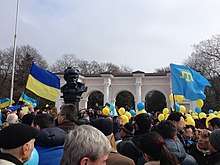
Following news of Crimea's independence "referendum" organized with the help of Russia on 16 March 2014, the Kurultai leadership voiced concerns of renewed persecution, as commented by a U.S. official before the visit of a UN human rights team to the peninsula.[123] At the same time, Rustam Minnikhanov, the president of Tatarstan was dispatched to Crimea to quell Crimean Tatars' concerns and to point out that "in the 23 years of Ukraine's independence the Ukrainian leaders have been using Crimean Tatars as pawns in their political games without doing them any tangible favors". The issue of Crimean Tatar persecution by Russia has since been raised regularly on an international level.[124][125]
On 18 March 2014, the day Crimea was annexed by Russia, and Crimean Tatar was de jure declared one of the three official languages of Crimea. It was also announced that Crimean Tatars will be required to relinquish coastal lands on which they squatted since their return to Crimea in early 1990s and be given land elsewhere in Crimea. Crimea stated it needed the relinquished land for "social purposes", since part of this land is occupied by the Crimean Tatars without legal documents of ownership.[126] The situation was caused by the inability of the USSR (and later Ukraine) to sell the land to Crimean Tatars at a reasonable price instead of giving back to the Tatars the land owned before deportation, once they or their descendants returned from Central Asia (mainly Uzbekistan). As a consequence, some Crimean Tatars settled as squatters, occupying land that was and is still not legally registered.
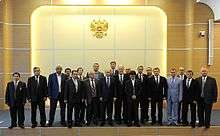
Some Crimean Tatars fled to Mainland Ukraine due to the Crimean crisis – reportedly around 2000 by 23 March.[127] On 29 March 2014, an emergency meeting of the Crimean Tatars representative body, the Kurultai, voted in favor of seeking "ethnic and territorial autonomy" for Crimean Tatars using "political and legal" means. The meeting was attended by the Head of the Republic of Tatarstan and the chair of the Russian Council of Muftis.[128] Decisions as to whether the Tatars will accept Russian passports or whether the autonomy sought would be within the Russian or Ukrainian state have been deferred pending further discussion.[129]
The Mejlis works in emergency mode in Kiev.[130]
After the annexation of Crimea by Russian Federation, Crimean Tatars are reportedly persecuted and discriminated by Russian authorities, including cases of torture, arbitrary detentions, forced disappearances by Russian security forces and courts.[131][132][133]
On 12 June 2018, Ukraine lodged a memorandum consisting of 17,500 pages of text in 29 volumes to the UN's International Court of Justice about racial discrimination against Crimean Tatars by Russian authorities in occupied Crimea and state financing of terrorism by Russian Federation in Donbass.[134][135]
Culture
Cuisine
Crimean Tatar political parties
National Movement of Crimean Tatars
Founded by Crimean Tatar civil rights activist Yuri Osmanov, the National Movement of Crimean Tatars (NDKT) was the major opposition faction to the Dzhemilev faction during the Soviet era. The official goal of the NDKT during the Soviet era was the restoration of the Crimean ASSR under the Leninist principle of national autonomy for titular indigenous peoples in their homeland, conflicting with the desires of an independent Tatar state from the OKND, the predecessor of the Mejilis. Yuri Osmanov, founder of the organization, was highly critical of Dzhemilev, saying that the OKND, the predecessor of the Mejilis, did not sufficiently try to mend ethnic tensions in Crimea. However, the OKND decreased in popularity after Yuri Osmanov was killed.[136][137][138]
Mejlis
In 1991, the Crimean Tatar leadership founded the Kurultai, or Parliament, to act as a representative body for the Crimean Tatars which could address grievances to the Ukrainian central government, the Crimean government, and international bodies.[139] Mejlis of the Crimean Tatar People is the executive body of the Kurultai.
Since the 1990s till October 2013, the political leader of the Crimean Tatars and the chairman of the Mejlis of the Crimean Tatar People was former Soviet dissident Mustafa Djemilev. Since October 2013 the chairman of the Mejlis of the Crimean Tatar People is Refat Chubarov.[140]
Following the 2014 Russian annexation of Crimea, Russian authorities declared the Mejlis of the Crimean Tatar People to be an extremist organization, and banned it on 26 April 2016.[141]
New Milliy Firqa
In 2006, a new Crimean Tatar party in opposition to the Mejlis was founded, taking the name of the previously-defunct Milly Firqa party from the early 20th century. The party claims to be successor of the ideas of Yuri Osmanov and NDKT.[142]
Crimean Tatars
See also
Notes
^ Controlled and administrated by the Russian Federation as Crimean Federal District: Republic of Crimea and federal city of Sevastopol. Recognized as a part of Ukraine by most of the international community as Autonomous Republic of Crimea and city with special status Sevastopol. Northern part of the Arabat Spit is a part of the Kherson Oblast and is not a subject of territorial dispute.
References
- "Archived copy". Archived from the original on 20 April 2015. Retrieved 7 January 2016.CS1 maint: archived copy as title (link)
- "Катастрофический фактор". kasparov.ru. Retrieved 27 March 2018.
- "Archived copy". Archived from the original on 27 April 2015. Retrieved 20 April 2015.CS1 maint: archived copy as title (link)
- Big Russian Encyclopedia – Crimean Tatars
- In Turkey, censuses do not indicate nationality, so it is impossible to say exactly (or even approximately) how many Crimean Tatars are in Turkey. However, it is known that no less than 6 million Turks are descendants of the Crimean Tatars who emigrated from Crimea and the Northern Black Sea region after 1783, when the Russian Empire annexed the Crimean Khanate. What part of them continues to consider themselves as Crimean Tatars, and which do not remember their roots, is unknown.
- "Crimean Tatars and Noghais in Turkey".
- "Recensamant Romania 2002". Agentia Nationala pentru Intreprinderi Mici si Mijlocii (in Romanian). 2002. Archived from the original on 13 May 2007. Retrieved 5 August 2007.
- Russian Census 2010: Population by ethnicity Archived 24 April 2012 at the Wayback Machine (in Russian)
- "Bulgaria Population census 2001".
- (in Russian) Агентство Республики Казахстан по статистике. Перепись 2009. Archived 1 May 2012 at the Wayback Machine (Национальный состав населения Archived 11 May 2011 at the Wayback Machine.rar)
- "История этногенеза крымских татар | Ана юрт". ana-yurt.com. Retrieved 18 December 2019.
- Verkhovna Rada recognized Crimean Tatars indigenous people of Ukraine (Рада визнала кримських татар корінним народом у складі України). Mirror Weekly. 20 March 2014
- Dahl, J. (2012). The Indigenous Space and Marginalized Peoples in the United Nations. Springer. pp. 240–241. ISBN 978-1-137-28054-1.
- Vanguri, Star (2016). Rhetorics of Names and Naming. Routledge. pp. 132–133. ISBN 978-1-317-43604-1.
- Yevstigneev, Yuri (2008). Россия: коренные народы и зарубежные диаспоры (краткий этно-исторический справочник) – lit. "Russia: indigenous peoples and foreign diasporas (a brief ethno-historical reference)" (in Russian). Saint Petersburg: Litres. ISBN 9785457236653. Retrieved 4 March 2020.
- Vozgrin, Valery "Historical fate of the Crimean Tatars" Archived 11 July 2006 at the Wayback Machine
- Sasse, Gwendolyn (2007). The Crimea Question: Identity, Transition, and Conflict. Harvard University Press. p. 93. ISBN 978-1-932650-01-3.
- Williams, Brian Glyn (1999). A Homeland Lost: Migration, the Diaspora Experience and the Forging of Crimean Tatar National Identity. University of Wisconsin-Madison. p. 541.
- Illarionov, A. (2014). "The ethnic composition of Crimea during three centuries" (in Russian). Moscow, R.F.: Institute of Economical Analysis. Archived from the original on 5 March 2014.
- Troynitski, N.A. (1905). "First General Census of Russian Empire's Population, 1897 (Первая Всеобщая перепись населения Российской Империи 1897 г. Под ред. Н.А.Тройницкого. т.II. Общий свод по Империи результатов разработки данных Первой Всеобщей переписи населения, произведенной 28 января 1897 года. С.-Петербург: типография "Общественная польза", 1899–1905, 89 томах (119 книг))" (in Russian). Saint Petersburg. Archived from the original on 6 October 2014.
- During the 2014 census, a significant part of those who indicated the nationality "Tatar" in the census were actually Crimean Tatars.
- "UNPO: Crimean Tatars". unpo.org. Retrieved 25 April 2019.
- "About number and composition population of UKRAINE by data All-Ukrainian population census'". Ukrainian Census (2001). State Statistics Committee of Ukraine. Archived from the original on 17 December 2011. Retrieved 20 November 2013.
- "About number and composition population of AUTONOMOUS REPUBLIC OF CRIMEA by data All-Ukrainian population census'". Ukrainian Census (2001). State Statistics Committee of Ukraine. Retrieved 20 November 2013.
- Crimean Tatars (КРИМСЬКІ ТАТАРИ). Encyclopedia of History of Ukraine.
- "The Crimean Tatars: The Diaspora Experience and the Forging of a Nation". Iccrimea.org. 18 May 1944. Retrieved 24 October 2012.
- Khodarkovsky – Russia's Steppe Frontier p. 11
- Williams, BG. The Crimean Tatars: The Diaspora Experience and the Forging of a Nation. Pgs 7–23. ISBN 90-04-12122-6
- István Vásáry (2005) Cumans and Tatars, Cambridge University Press.
- Stearns(1979:39–40).
- "CUMAN". Christusrex.org. Archived from the original on 16 October 2012. Retrieved 24 October 2012.
- Stearns (1978). "Sources for the Krimgotische". p. 37. Archived from the original on 24 July 2011. Retrieved 12 February 2011.
- Brian Glyn Williams (2001). The Crimean Tatars: The Diaspora Experience and the Forging of a Nation. BRILL. p. 37. ISBN 90-04-12122-6.
- Marc Weller; Stefan Wolff (2005). Autonomy, Self Governance and Conflict Resolution: Innovative approaches to Institutional Design in Divided Societies. Taylor & Francis. p. 81. ISBN 978-0-203-46191-4.
- Williams, Brian Glyn. 2001. "The Ethnogenesis of the Crimean Tatars. An Historical Reinterpretation". Journal of the Royal Asiatic Society 11 (3). Cambridge University Press: 329–48. https://www.jstor.org/stable/25188176.
- William Zebina Ripley (1899). The Races of Europe: A Sociological Study (Lowell Institute Lectures). D. Appleton and Company. pp. 420–.
crimean tatar language.
- The Encyclopædia Britannica: The New Volumes, Constituting, in Combination with the Twenty-nine Volumes of the Eleventh Edition, the Twelfth Edition of that Work, and Also Supplying a New, Distinctive, and Independent Library of Reference Dealing with Events and Developments of the Period 1910 to 1921 Inclusive. Encyclopædia Britannica Company, Limited. 1911. pp. 448–.
- Очерки истории и культуры крымских татар. / Под. ред. Э. Чубарова. — Симферополь, Крымучпедгиз, 2005.
- А. И. Айбабин Этническая история ранневизантийского Крыма. Симферополь. Дар. 1999
- Мухамедьяров Ш. Ф. Введение в этническую историю Крыма. // Тюркские народы Крыма: Караимы. Крымские татары. Крымчаки. — Moscow: Наука. 2003.
- Хайруддинов М. А. К вопросу об этногенезе крымских татар/М. А. Хайруддинов // Ученые записки Крымского государственного индустриально-педагогического института. Выпуск 2. -Симферополь, 2001.
- Sevortyan E. V. Crimean Tatar language. // Languages of the peoples of the USSR. — t. 2 (Turkic languages). — N., 1966. — Pp. 234–259.
- "Baskakov – on the classification of Turkic languages". www. philology. ru. Retrieved 16 February 2017.
- Essays on the history and culture of the Crimean Tatars. / Under. edited by E. Chubarova.Simferopol, Crimecity, 2005.
- Brian Glyn Williams (2015). The Crimean Tatars: From Soviet Genocide to Putin's Conquest. Oxford University Press. p. xi–xii. ISBN 9780190494704.
- Gertsen, Mogarychev Крепость драгоценностей. Кырк-Ор. Чуфут-кале., 1993, pages 58—64. — ISBN 5-7780-0216-5.
- Brian L. Davies (2014). Warfare, State and Society on the Black Sea Steppe. pp. 15–26. Routledge.
- Крымское ханство: вассалитет или независимость? // Османский мир и османистика. Сборник статей к 100-летию со дня рождения А.С. Тверитиновой (1910–1973) М., 2010. С. 288–298
- Williams, BG. The Crimean Tatars: The Diaspora Experience and the Forging of a Nation. Pg 12. ISBN 90-04-12122-6
- Rayfield, Donald, 2014: "Dormant claims", Times Literary Supplement, 9 May 2014 p 15
- Gayvoronsky, 2007
- Vosgrin, 1992. ISBN 5-244-00641-X.
- Halil İnalcik, 1942
- Great Russian Encyclopedia: Верховная власть принадлежала хану – представителю династии Гиреев, который являлся вассалом тур. султана (официально закреплено в 1580-х гг., когда имя султана стало произноситься перед именем хана во время пятничной молитвы, что в мусульм. мире служило признаком вассалитета)
- Kochegarov (2008), p. 230
- J. Tyszkiewicz. Tatarzy na Litwie i w Polsce. Studia z dziejow XIII-XVIII w. Warszawa, 1989. p. 167
- Davies (2007), p. 187; Torke (1997), p. 110
- There is a popular thesis in the Russian-Soviet propaganda about the Crimean Tatars betrayal of Khmelnytsky. However, the words of the vizier of the Crimean khanate Sefer Ğazı show just the opposite. He said: «The Zaporozhian Cossacks spent 800 years in servitude with the Polish kings, then seven years with us, and we, taking them together and hoping that they would be righteous and standing in service, defended them, fought for them with Poland and Lithuania, shed a lot of innocent blood, and did not allow them to be harmed. Back then there were only 8,000 Cossacks, and we Tatars made 20,000 of them. The Cossacks liked it, when we covered them and always came to their aid, then Khmelnytsky kissed me, Sefergazy-Aga, in the legs and wanted to be with us in submission forever. Now the Cossacks have misappropriated us, betrayed us, forgotten our goodness, gone to the Tsar of Moscow. You, members, know that it is traitors and rebels who will betray the Tsar just as they betrayed us and the Poles. Mehmed Giray the Tsar is unable to do anything but to walk on them and destroy them. I do not think any of the Crimeans and Nogais will have a claw on the fingers of their hands, I don't think their eyes will be covered with ground – then only the treachery and the Cossack faith will be avenged.» (source of the quote)
- Ahmad III, H. Bowen, The Encyclopaedia of Islam, Vol. I, ed. H.A.R. Gibb, J.H. Kramers, E. Levi-Provencal and J. Shacht, (E.J.Brill, 1986), 269.
- He was claiming: "Such a strong and merciless enemy as Moscow, falling on its feet, fell into our hands. This is such a convenient case when, if we wish so, we can capture Russia from one side to the other, since I know for sure that the whole the strength of the Russian army is this army. Our task now is to pat the Russian army so that it cannot move anywhere from this place, and we will get to Moscow and bring the matter to the point that the Russian Tsar would be appointed by our padishah" (Halim Giray, 1822)
- Halim Giray, 1822 (in Russian)
- Tucker, Spencer C. (2010). A Global Chronology of Conflict: From the Ancient World to the Modern Middle East, Vol. II. ABC-CLIO. p. 732
- Great Russian Encyclopedia: Крымское ханство — A. V. Vinogradov, S. F. Faizov
- Subtelny, Orest (2000). "Ukraine: A History". University of Toronto Press. pp. 105–106.
- Paul Robert, Magocsi (2010). A History of Ukraine: The Land and Its Peoples, Second Edition. University of Toronto Press. p. 185. ISBN 978-1442698796.
- "The Crimean Tatars and the Ottomans". Hürriyet Daily News. 29 March 2014.
- Mikhail Kizilov (2007). "Slave Trade in the Early Modern Crimea From the Perspective of Christian, Muslim, and Jewish Sources". Journal of Early Modern History. Oxford University. 11 (1): 2–7. doi:10.1163/157006507780385125.
- Yermolenko, Galina I. (2010). Roxolana in European Literature, History and Culture. Ashgate Publishing, Ltd. p. 111. ISBN 978-1409403746.
- "The Crimean Tatars and their Russian-Captive Slaves Archived 5 June 2013 at the Wayback Machine" (PDF). Eizo Matsuki, Mediterranean Studies Group at Hitotsubashi University.
- Fisher, Alan (1981). "The Ottoman Crimea in the Sixteenth Century". Harvard Ukrainian Studies. 5 (2): 135–170. JSTOR 41035903.
- Alan W. Fisher, The Russian Annexation of the Crimea 1772–1783, Cambridge University Press, p. 26.
- "Украине не стоит придумывать мифы о Крыме, ведь он украинский по праву – историк" (in Russian). Крим.Реалії. 6 січня 2016. Retrieved 16 травня 2020. Check date values in:
|accessdate=, |date=(help) - Bykova 2015, p. 34.
- Serhiychuk 2008, p. 216.
- Great Russian Encyclopedia: Crimean Khanate
- Религия Караимов, Глаголев В. С., page 88
- Darjusz Kołodziejczyk, as reported by Mikhail Kizilov (2007). "Slaves, Money Lenders, and Prisoner Guards:The Jews and the Trade in Slaves and Captivesin the Crimean Khanate". The Journal of Jewish Studies: 2.
- Brian Glyn Williams (2013). "The Sultan's Raiders: The Military Role of the Crimean Tatars in the Ottoman Empire" (PDF). The Jamestown Foundation. Archived from the original (PDF) on 21 October 2013.
- The historical fate of the Crimean Tatars — Doctor of Historical Sciences, Professor Valery Vozgrin, 1992, Moscow (in Russian)
- The economy of the Crimean Khanate
- RFEL:Сергей Громенко против «лысенковщины» в истории Крыма (in Russian)
- Как переписывали историю Крыма (How the Crimean history was rewritten)
- Serhiy Hromenko «Все было не так»: зачем Россия переписывает историю Крыма
- Gulnara Bekirova: Крымскотатарская проблема в СССР: 1944–1991
- Gulnara Bekirova Crimea and the Crimean Tatars in XIX—XXth centuries, 2005, page 95
- "Hijra and Forced Migration from Nineteenth-Century Russia to the Ottoman Empire" Archived 11 June 2007 at the Wayback Machine, by Bryan Glynn Williams, Cahiers du Monde russe, 41/1, 2000, pp. 79–108.
- Хаяли Л. И. — Провозглашение Крымской народной республики (декабрь 1917 года)
- Maria Drohobycky, Crimea: Dynamics, Challenges and Prospects, Rowman & Littlefield, 1995, p.91, ISBN 0847680673
- Minahan, James (2000). Europe, many nations: a historical dictionary of European national groups. p. 189. ISBN 9780313309847.
- "The Crimean Tatars: A Primer". newrepublic.com. Retrieved 27 March 2018.
- Aurélie Campana, Sürgün: "The Crimean Tatars’ deportation and exile, Online Encyclopedia of Mass Violence", 16 June 2008. Retrieved 19 April 2012, ISSN 1961-9898
- Subtelny, Orest (2000). Ukraine: A History. University of Toronto Press. p. 483. ISBN 0-8020-8390-0.
- The Muzhik & the Commissar, Time, 30 November 1953
- Fisher, Alan W. (2014). Crimean Tatars. Hoover Press. pp. 250–252. ISBN 9780817966638.
- Williams, Brian Glyn (2015). The Crimean Tatars: From Soviet Genocide to Putin's Conquest. Oxford University Press. pp. 107–108. ISBN 9780190494711.
- Uehling, Greta (26 November 2004). Beyond Memory: The Crimean Tatars' Deportation and Return. Springer. p. 100. ISBN 9781403981271.
- Allworth, Edward (1998). The Tatars of Crimea: Return to the Homeland : Studies and Documents. Duke University Press. pp. 225–227. ISBN 9780822319948.
- Stronski, Paul (2010). Tashkent: Forging a Soviet City, 1930–1966. University of Pittsburgh Pre. ISBN 9780822973898.
- Naimark, Norman (2002). Fires of Hatred. Harvard University Press. pp. 67–69. ISBN 9780674975828.
- Buckley, Cynthia J.; Ruble, Blair A.; Hofmann, Erin Trouth (2008). Migration, Homeland, and Belonging in Eurasia. Woodrow Wilson Center Press. p. 213. ISBN 9780801890758.
- Williams, Brian Glyn (2015). The Crimean Tatars: From Soviet Genocide to Putin's Conquest. Oxford University Press. pp. 108, 136. ISBN 9780190494704.
- Buttino, Marco (1993). In a Collapsing Empire: Underdevelopment, Ethnic Conflicts and Nationalisms in the Soviet Union, p.68 ISBN 88-07-99048-2
- United States Congress Commission on Security and Cooperation in Europe (1977). Basket Three, Implementation of the Helsinki Accords: Religious liberty and minority rights in the Soviet Union. Helsinki compliance in Eastern Europe. U.S. Government Printing Office. p. 261.
- Report. The Group. 1970. pp. 14–20.
- Williams, Brian Glyn (2001). The Crimean Tatars: The Diaspora Experience and the Forging of a Nation. BRILL. ISBN 9789004121225.
- Allworth, Edward (1988). Tatars of the Crimea: Their Struggle for Survival : Original Studies from North America, Unofficial and Official Documents from Czarist and Soviet Sources. Duke University Press. pp. 55, 167–169. ISBN 9780822307587.
- Gromenko, Sergey (2016). Наш Крим: неросійські історії українського півострова (in Ukrainian). Український інститут національної пам’яті. pp. 283–286. ISBN 9786176841531.
- Yakupova, Venera (2009). Крымские татары, или Привет от Сталина! (PDF). Kazan: Часы истории. pp. 28–30, 47–48.
- Russia. Chalidze Publication. 1983. pp. 121–122.
- Smith, Graham (1996). The nationalities question in the post-Soviet states. Longman. ISBN 9780582218086.
- Fouse, Gary C. (2000). The Languages of the Former Soviet Republics: Their History and Development. University Press of America. p. 340. ISBN 9780761816072.
- Mastny, Vojtech (2019). Soviet/east European Survey, 1987-1988: Selected Research And Analysis From Radio Free Europe/radio Liberty. Routledge. p. 133. ISBN 9781000312751.
- Country Reports on Human Rights Practices: Report Submitted to the Committee on Foreign Affairs, U.S. House of Representatives and Committee on Foreign Relations, U.S. Senate by the Department of State in Accordance with Sections 116(d) and 502B(b) of the Foreign Assistance Act of 1961, as Amended. U.S. Government Printing Office. 1989. p. 1230.
- Human Rights Watch 1991, p. 38.
- Vyatkin, Anatoly (1997). Крымские татары: проблемы репатриации (in Russian). Ин-т востоковедения РАН. p. 32. ISBN 9785892820318.
- Olcott, Martha Brill; Hajda, Lubomyr; Olcott, Anthony (26 July 2019). The Soviet Multinational State. Routledge. ISBN 9781315494432.
- Dichkov, Aleksandr (2018). Загадка древнего завета. Исторический детектив (in Russian). Litres. p. 701. ISBN 9785040537594.
- Bekirova, Gulnara (1 April 2016). "Юрий Османов". Крым.Реалии (in Russian). Retrieved 13 September 2019.
- Skutsch, Carl (2005). Encyclopedia of the world's minorities. Routledge. p. 1190. ISBN 9781579584702.
- Arbatov, Aleksey; Lynn-Jones, Sean; Motley, Karen (1997). Managing Conflict in the Former Soviet Union: Russian and American Perspectives. MIT Press. pp. 96–97. ISBN 9780262510936.
- Gabrielyan, Oleg (1998). Крымские репатрианты: депортация, возвращение и обустройство (in Russian). Amena. p. 321.
- "U.N. human rights team aims for quick access to Crimea – official". Retrieved 20 March 2014.
- "UNPO: Crimean Tatars: Turkey Officially Condemns Persecution by Russia". unpo.org. Retrieved 27 March 2018.
- http://politicalperiscope.com/crimean-tatars-russia/
- Temirgaliyev, Rustam. "Crimean Deputy Prime Minister". Retrieved 19 March 2014.
- Trukhan, Vassyl. "Crimea's Tatars flee for Ukraine far west". Yahoo. Retrieved 23 March 2014.
- "Crimean Tatars' want autonomy after Russia's seizure of peninsula". Reuters.
- "World".
- "UNPO: Crimean Tatars: Mejlis Continues Work in Emergency Mode from Kiev". unpo.org. Retrieved 27 March 2018.
- "Crimea: Persecution of Crimean Tatars Intensifies | Human Rights Watch".
- "UN documents torture and arrests of Crimean Tatars by Russia – 12.12.2017 14:44 — Ukrinform News".
- "UN accuses Russia of multiple human rights abuses". The Independent. 16 November 2016. Retrieved 21 June 2017.
- "UAWire – Ukraine files memorandum with UN Court of Justice containing evidence of Russia's involvement in 'financing of terrorism'".
- "Ukraine submits to ICJ evidence of Russian crimes in Crimea, Donbas | UNIAN".
- Yang, Yering (2010). Национализм в поздне-- и посткоммунистической Европе (in Russian). Rosspen. p. 216.
- Kasyanenko, Nikita (14 April 2001). "...К сыну от отца – закалять сердца". day.kyiv.ua.
- Расы и народы (in Russian). Nauka. 1997. p. 124.
- Ziad, Waleed; Laryssa Chomiak (20 February 2007). "A Lesson in Stifling Violent Extremism: Crimea's Tatars have created a promising model to lessen ethnoreligious conflict". CS Monitor. Retrieved 6 August 2007.
- "Chairman". qtmm.org. Retrieved 25 June 2016.
- Crimean court bans Tatar ruling body in blow to minority, The Star (Malaysia) (26 April 2016)
- Kashikhin, Borislav; Svetlova, Kseniya (13 September 2017). "Лепестки роз в «коктейле Молотова»".
Further reading
- Conquest, Robert. 1970. The Nation Killers: The Soviet Deportation of Nationalities (London: Macmillan). (ISBN 0-333-10575-3)
- Fisher, Alan W. 1978. The Crimean Tatars. Stanford, CA: Hoover Institution Press. (ISBN 0-8179-6661-7)
- Fisher, Alan W. 1998. Between Russians, Ottomans and Turks: Crimea and Crimean Tatars (Istanbul: Isis Press, 1998). (ISBN 975-428-126-2)
- Nekrich, Alexander. 1978. The Punished Peoples: The Deportation and Fate of Soviet Minorities at the End of the Second World War (New York: W. W. Norton). (ISBN 0-393-00068-0)
- Quelquejay, Lemercier. "The Tatars of the Crimea, a retrospective summary." Central Asian Review 16#1 (1968): 15–25.
- Uehling, Greta (June 2000). "Squatting, self-immolation, and the repatriation of Crimean Tatars". Nationalities Papers. 28 (2): 317–341. doi:10.1080/713687470. S2CID 140736004.
- Williams, Brian Glyn. "The hidden ethnic cleansing of Muslims in the Soviet Union: The exile and repatriation of the Crimean Tatars." Journal of Contemporary History (2002): 323–347. in JSTOR
- Williams, Brian Glyn. "The Crimean Tatar exile in Central Asia: a case study in group destruction and survival." Central Asian Survey 17.2 (1998): 285–317.
- Williams, Brian Glyn. "The Ethnogenesis of the Crimean Tatars. An Historical Reinterpretation" Journal of the Royal Asiatic Society (2001) 11#3 pp. 329–348 in JSTOR
- Williams, Brian G., The Crimean Tatars: The Diaspora Experience and the Forging of a Nation, Leyden: Brill, 2001.
Other languages
- Vozgrin, Valery, 2013, Istoriya krymskykh tatar ((in Russian) Valery Vozgrin "Исторические судьбы крымских татар"), Simferopol (four volumes).
- Smirnov V D, 1886, Krymskoe khanstvo
- Campana (Aurélie), Dufaud (Grégory) and Tournon (Sophie) (ed.), Les Déportations en héritage. Les peuples réprimés du Caucase et de Crimée, hier et aujourd'hui, Rennes: Presses universitaires de Rennes, 2009.
- Bykova, Tetyana (2015). Політичне та соціально-економічне становище в Криму (від середини XVIII ст. до 1917 р.) (PDF). Kyiv.CS1 maint: ref=harv (link)
- Serhiychuk, Volodymyr (2008). Етнічні межі і державний кордон України. Kyiv: ПП Сергійчук M. І. ISBN 978-966-2911-24-4.CS1 maint: ref=harv (link)
External links
| Wikimedia Commons has media related to Crimean Tatars. |
- Official website of Qirim Tatar Cultural Association of Canada
- Official web-site of Bizim QIRIM International Nongovernmental Organization
- International Committee for Crimea
- UNDP Crimea Integration and Development Programme
- Crimean Tatar Home Page
- Crimean Tatars
- Crimean Tatar words (Turkish)
- Crimean Tatar words (English)
- State Defense Committee Decree No. 5859ss: On Crimean Tatars (See also Three answers to the Decree No. 5859ss)
- Crimean Tatars; Essays on Central Asia Index Essays on Central Asia Index
- 'Крымская солидарность; ВОЗВРАЩЕНИЕ ДОМОЙ. РУСТЕМ ВАИТОВ' (YouTube channel of Crimean Tatar Solidarity; story of Rustem Vaitov returning home after 5 years of jail)
